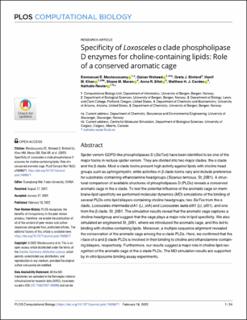| dc.contributor.author | Moutoussamy, Emmanuel Edouard | |
| dc.contributor.author | Waheed, Qaiser | |
| dc.contributor.author | Binford, Greta J. | |
| dc.contributor.author | Khan, Hanif Muhammad | |
| dc.contributor.author | Moran, Shane M. | |
| dc.contributor.author | Eitel, Anna R. | |
| dc.contributor.author | Cordes, Matthew H.J. | |
| dc.contributor.author | Reuter, Nathalie | |
| dc.date.accessioned | 2022-06-21T12:54:09Z | |
| dc.date.available | 2022-06-21T12:54:09Z | |
| dc.date.created | 2022-05-25T09:24:50Z | |
| dc.date.issued | 2022 | |
| dc.identifier.issn | 1553-734X | |
| dc.identifier.uri | https://hdl.handle.net/11250/2999858 | |
| dc.description.abstract | Spider venom GDPD-like phospholipases D (SicTox) have been identified to be one of the major toxins in recluse spider venom. They are divided into two major clades: the α clade and the β clade. Most α clade toxins present high activity against lipids with choline head groups such as sphingomyelin, while activities in β clade toxins vary and include preference for substrates containing ethanolamine headgroups (Sicarius terrosus, St_βIB1). A structural comparison of available structures of phospholipases D (PLDs) reveals a conserved aromatic cage in the α clade. To test the potential influence of the aromatic cage on membrane-lipid specificity we performed molecular dynamics (MD) simulations of the binding of several PLDs onto lipid bilayers containing choline headgroups; two SicTox from the α clade, Loxosceles intermedia αIA1 (Li_αIA) and Loxosceles laeta αIII1 (Ll_αIII1), and one from the β clade, St_βIB1. The simulation results reveal that the aromatic cage captures a choline-headgroup and suggest that the cage plays a major role in lipid specificity. We also simulated an engineered St_βIB1, where we introduced the aromatic cage, and this led to binding with choline-containing lipids. Moreover, a multiple sequence alignment revealed the conservation of the aromatic cage among the α clade PLDs. Here, we confirmed that the i-face of α and β clade PLDs is involved in their binding to choline and ethanolamine-containing bilayers, respectively. Furthermore, our results suggest a major role in choline lipid recognition of the aromatic cage of the α clade PLDs. The MD simulation results are supported by in vitro liposome binding assay experiments. | en_US |
| dc.language.iso | eng | en_US |
| dc.publisher | PLOS | en_US |
| dc.rights | Navngivelse 4.0 Internasjonal | * |
| dc.rights.uri | http://creativecommons.org/licenses/by/4.0/deed.no | * |
| dc.title | Specificity of Loxosceles α clade phospholipase D enzymes for choline-containing lipids: Role of a conserved aromatic cage | en_US |
| dc.type | Journal article | en_US |
| dc.type | Peer reviewed | en_US |
| dc.description.version | publishedVersion | en_US |
| dc.rights.holder | Copyright 2022 The Author(s) | en_US |
| dc.source.articlenumber | e1009871 | en_US |
| cristin.ispublished | true | |
| cristin.fulltext | original | |
| cristin.qualitycode | 2 | |
| dc.identifier.doi | 10.1371/journal.pcbi.1009871 | |
| dc.identifier.cristin | 2027193 | |
| dc.source.journal | PLoS Computational Biology | en_US |
| dc.identifier.citation | PLoS Computational Biology. 2022, 18 (2), e1009871. | en_US |
| dc.source.volume | 18 | en_US |
| dc.source.issue | 2 | en_US |

